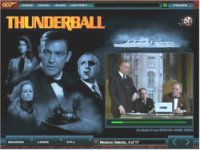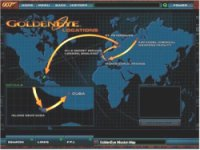The Ultimate Review for The Ultimate James Bond: An Interactive Dossier
 James Bond fans have been passed over by CD-ROM companies for years. While we watched the industry spit out everything from Julia Child’s Cooking to The African Wildebeest at Play, we had to sit idly by and just hope the multimedia Gods would smile on us. Thankfully, our prayers have finally been answered.
James Bond fans have been passed over by CD-ROM companies for years. While we watched the industry spit out everything from Julia Child’s Cooking to The African Wildebeest at Play, we had to sit idly by and just hope the multimedia Gods would smile on us. Thankfully, our prayers have finally been answered.
With the release of The Ultimate James Bond: An Interactive Dossier (MGM Interactive, $44.95), Bond fans have been given one of the most advanced, in-depth, enjoyable CD-ROM products to hit the market in years. The presentation and content are utterly first-rate, and, even after eight hours with it, you come away feeling as though you’ve barely scratched the surface.
The Dossier arrives on two discs. The install guide is minimal – and rightfully so. If you can type “D: INSTALL” you should be fine. The Dossier slips onto your hard drive with little fanfare and consumes a relatively paltry 13.3 MB of space. (Why this much, you ask? Apparently the entire opening sequence – an absolutely stunning piece of work – installs itself onto your hard drive to avoid any data transfer problems.)
 The Dossier is built around a massive 007 database with entries for everything from Miss Moneypenny to the three-wheelers from Diamonds Are Forever. Individual stops are included which cover all the bases, from concrete items like the Acrostar jet to such abstract concepts as “romance” and “witticism.” The text – written in part by John Cork (editor of “Goldeneye” magazine) and Lee Pfeiffer (co-author of “The Incredible World of 007”) – is downright downright dizzying in its inclusiveness.
The Dossier is built around a massive 007 database with entries for everything from Miss Moneypenny to the three-wheelers from Diamonds Are Forever. Individual stops are included which cover all the bases, from concrete items like the Acrostar jet to such abstract concepts as “romance” and “witticism.” The text – written in part by John Cork (editor of “Goldeneye” magazine) and Lee Pfeiffer (co-author of “The Incredible World of 007”) – is downright downright dizzying in its inclusiveness.
For example, the entry on Kara Milovoy’s cello, The Lady Rose, runs about 400 words and essentially retells the plot of The Living Daylights. Not enough? Hit the “FYI” button for selected behind-the-scenes information and trivia. For the aforementioned entry, you’re treated to a paragraph on Antonio Stradivari, the real-life legend that supposedly made the instrument.
The database is searchable by text or keyword, and you can organize results by alphabetical list, by film, or by “class” (Example: Women break down into Allies, Villains, Turncoats, and Lovers. Obviously, there’s some overlap.). Each entry is hyperlinked and the cursor changes to a little gunsight as it passes over linked text. “Back” and “Forward” arrows are included that allow you to navigate the database like a Web browser.
 Along with the staggering amount of textual content, the Dossier offers a fantastic array of multimedia. Full-motion film segments abound. Some are linear, but most are wonderfully-edited collections of clips dealing with a particular subject. The section on women, for instance, is a 60-second tour of Bond beauties throughout the series. Similar entries are included for Bond’s vehicles, enemies, gadgets, allies, and a lengthy bit on each of the 17 films. Also included are hi-resolution photo stills, many of which are linked to audio clips.
Along with the staggering amount of textual content, the Dossier offers a fantastic array of multimedia. Full-motion film segments abound. Some are linear, but most are wonderfully-edited collections of clips dealing with a particular subject. The section on women, for instance, is a 60-second tour of Bond beauties throughout the series. Similar entries are included for Bond’s vehicles, enemies, gadgets, allies, and a lengthy bit on each of the 17 films. Also included are hi-resolution photo stills, many of which are linked to audio clips.
The multimedia is nicely integrated with the database entries. The “romance” entry, for example, provides several paragraphs about Bond’s amorous exploits, and offers a lengthy film clip of Bond’s proposal to Tracy from On Her Majesty’s Secret Service, an audio clip of Bond and Sylvia Trench from the beginning of From Russia With Love, and a photo still of Bond putting flowers on Tracy’s grave in the For Your Eyes Only teaser.
And just when you think you’re seen enough, the Dossier just keeps spitting out more content. Additional highlights include:
The “007 Declassified” section, providing information about the Broccolis and the actors that have played the role, a timeline by decade and by year of events in the world of Bond (did you know that People Magazine ran a picture of Moore and Connery kissing each other in 1992?), and a profile of 007 as created by Fleming and refined and altered by the films.
 Entries for each of the 17 films that provide colossal amounts of information, including (1) at least 1,000 words of plot summary, (2) a credit and cast list (hyperlinked, of course), (3) a listing of all related items in the database, (4) release information including a movie poster, newspaper and magazine reviews, and a list of world events that happened around the time the film was released, (5) a “Locations” map, complete with animated arrows which move from place to place, (6) and a “Backlot” section comprised of numerous behind-the-scenes photos shot during filming. All of this is in addition to the lengthy montage film clip that covers the highlights of the movie.
Entries for each of the 17 films that provide colossal amounts of information, including (1) at least 1,000 words of plot summary, (2) a credit and cast list (hyperlinked, of course), (3) a listing of all related items in the database, (4) release information including a movie poster, newspaper and magazine reviews, and a list of world events that happened around the time the film was released, (5) a “Locations” map, complete with animated arrows which move from place to place, (6) and a “Backlot” section comprised of numerous behind-the-scenes photos shot during filming. All of this is in addition to the lengthy montage film clip that covers the highlights of the movie. A nice trivia game with questions of increasingly difficulty. Unfortunately, you’ll encounter duplicate questions the second or third time through. Evidently, when completed, there’s a code that you plug into MGM/UA’s Web site to get a prize of some sort. (Sorry, but I never got past level three.)
A nice trivia game with questions of increasingly difficulty. Unfortunately, you’ll encounter duplicate questions the second or third time through. Evidently, when completed, there’s a code that you plug into MGM/UA’s Web site to get a prize of some sort. (Sorry, but I never got past level three.)A nice help screen with a clip of Desmond Llewelyn as Q. As the clip opens, he says to someone off-screen, “Well, just tell 007 that he’ll have to wait!”
As is probably inevitable in a project of this scope, there are the occasional slip-ups in data. For example, the photo that accompanies the one-page bio devoted to Robert Brown (the second “M”) is actually a picture of Geoffrey Keen (Defense Minister Frederick Gray). And if some of the biographical information on James Bond seems unfamiliar, it’s because it came not from Ian Fleming, or even the films, but from the “21st Anniversary” James Bond special produced for American TV with the aid of EON. CD-ROM co-author John Cork has stated that his team turned to sources like the TV special and EON’s p.r. materials to fill in the blanks of Bond’s early life, since the films reveal next to nothing and Fleming’s writings were off-limits legally. Understandable, perhaps, but as the only section of text not supportable by the films themselves, it stands out. An equally viable alternative would have been to leave Bond’s youth a mystery, as the films have done without complaint.
 The content and multimedia are distinctively packaged with original artwork and stirring background music. Most comes from Eric Serra’s GoldenEye score, but each of the films boast selections from their own soundtracks.
The content and multimedia are distinctively packaged with original artwork and stirring background music. Most comes from Eric Serra’s GoldenEye score, but each of the films boast selections from their own soundtracks.
But all this fun comes with a price, and that price is paid in your CD-ROM’s transfer rate. For the record, the Dossier is probably the most data-transfer intensive product on the market. Double-speed CD-ROM? Don’t even bother. Quad-speed? Doubtful. Six-speed? At least. At lower transfer speeds the sound and video cuts out and the CD often grinds to halt as it searches for something. It’s usable at lower CD-ROM speeds, but very frustrating.
Also bothersome is the inescapable fact that all the content and multimedia just can’t fit on one CD. All the text is on Disc One, but you’ll have to switch discs to access multimedia for films after Diamonds Are Forever. You’re given the option to skip the show if you just want the text.
Other complaints are minor: The CD plays little sound effects whenever you pull down a menu or press a button. They begin to wear thin after 30 minutes or so, and I couldn’t find a way to shut them off. Also, the interface “takes over” your Windows 95 desktop – that is, it blacks everything out and covers up the Taskbar. Admittedly small points, but mildly aggravating.

But, other than the transfer rate necessary to run the CD at full-speed, the technical issues are minor and they fade away completely in the face of the incredible content and vivid presentation. The Ultimate James Bond: An Interactive Dossier is the product that Bond fans have been clamoring for. It does not disappoint.
- Content: A
- Presentation: A+
- Technical: B